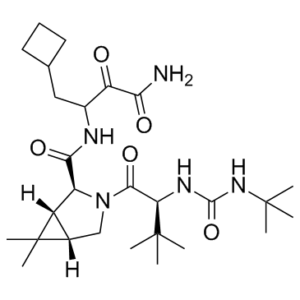This product is for research use only, not for human use. We do not sell to patients.

| Size | Price | Stock |
|---|---|---|
| 250mg | $420 | Check With Us |
| 500mg | $520 | Check With Us |
| 1g | $780 | Check With Us |
Cat #: V3157 CAS #: 394730-60-0 Purity ≥ 98%
Description: Boceprevir (previously known as EBP 520; SCH 503034; trade name: Victrelis) is a novel, orally bioavailable, selective, direct acting inhibitor of hepatitis C virus (HCV) protease with Ki value of 14 nM for NS3 in an enzyme assay and EC90 of 350 nM in cell-based replicon assay. It is an FDA approved drug (trade name: Victrelis) used in combination with other antiviral agents for the treatment of chronic hepatitis C, genotype 1. It exerts the effects by binding to the nonstructural 3 NS3 (HCV) active site of HCV.
Publications Citing InvivoChem Products
Product Promise

- Physicochemical and Storage Information
- Protocol
- Related Biological Data
- Stock Solution Preparation
- Quality Control Documentation
| Molecular Weight (MW) | 519.68 |
|---|---|
| Molecular Formula | C27H45N5O5 |
| CAS No. | 394730-60-0 |
| Storage | -20℃ for 3 years in powder formr |
| -80℃ for 2 years in solvent | |
| Solubility In Vitro | DMSO: >100 mg/mL (192.4 mM)r |
| Water: < 1 mg/mLr | |
| Ethanol: >100 mg/mL (192.4 mM) | |
| SMILES Code | O=C(N1[C@@H]([C@@]2([H])C(C)([C@]2(C1)[H])C)C(NC(C(C(N)=O)=O)CC3CCC3)=O)[C@@H](NC(NC (C)(C)C)=O)C(C)(C)C |
| Synonyms | EBP 520; EBP-520; EBP520; SCH-503034; SCH503034; SCH 503034; trade name: Victrelis. |
| Protocol | In Vitro | In vitro activity: Boceprevir (SCH 503034) has an average Ki value of 14 nM over a large number of runs in the HCV NS3 protease continuous assay. In the 72-h bicistronic subgenomic cell-based replicon assay in HuH-7 cells, the EC50 and EC90 values are determined to be 0.20 µM and 0.35 µM, respectively. Boceprevir is also found to be a very weak inhibitor of HNE (Ki=26 µM) representing a selectivity of 2200. Kinase Assay: Boceprevir is a novel, potent, highly selective, orally bioavailable HCV NS3 protease inhibitor with Ki of 14 nM in both enzyme assay and EC90 of 350 nM in cell-based replicon assay. Cell Assay: J774A.1 cells (a murine macrophage cell line) are plated at 5×104 cells/well in a 96 multiwell plate for 24 hours in RPMI medium supplemented with 10% of fetal bovine serum (FBS). The cells are primed with Escherichia coli 0111:B4 LPS(1 μg/ml) for 4 hours and then ATP (5 mM) for 30 minutes to induce the NLRP3 inflammasome formation. The supernatants are collected and levels of IL-1β are measured with a mouse IL-1β ELISA kit. To test the inhibitory effects of 16673-34-0 on NLRP3 inflammasome activation, cells are co-treated with 16673-34-0 (400μM) or Glyburide (400μM) at the time of ATP for 30 minutes, and IL-1β levels are used as read-out. |
|---|---|---|
| In Vivo | Boceprevir is an HCV Protease Inhibitor for the Treatment of HCV infection. The pharmacokinetic profile of Boceprevir is evaluated in several animal species. Following oral administration, Boceprevir is moderately absorbed in rats (10 mg/kg), dogs (3 mg/kg), and monkeys (3 mg/kg). Absorption is relatively rapid in dogs but slower in mice (10 mg/kg), rats, and monkeys, as evidenced by mean absorption times (MAT) ranging from 0.5 to 1.4 h. The AUC is good in dogs and rats, moderate in mouse, and low in monkeys. The absolute oral bioavailability is modest in mouse, rats, and dogs (26-34%) but low in monkeys (4%). Boceprevir (100 mg/kg, orally) inhibit HCV NS3/4A protease activity in triple-transgenic mice. | |
| Animal model | CD1 mice | |
| Formulation | Dissolved in DMSO | |
| Dosages | 100 mg/kg | |
| Administration | i.p. and p.o. |
| Solvent volume to be added | Mass (the weight of a compound) | |||
|---|---|---|---|---|
| Mother liquor concentration | 1mg | 5mg | 10mg | 20mg |
| 1mM | 1.9243 mL | 9.6213 mL | 19.2426 mL | 38.4852 mL |
| 5mM | 0.3849 mL | 1.9243 mL | 3.8485 mL | 7.6970 mL |
| 10mM | 0.1924 mL | 0.9621 mL | 1.9243 mL | 3.8485 mL |
| 20mM | 0.0962 mL | 0.4811 mL | 0.9621 mL | 1.9243 mL |
This equation is commonly abbreviated as: C1 V1 = C2 V2
- (1) Please be sure that the solution is clear before the addition of next solvent. Dissolution methods like vortex, ultrasound or warming and heat may be used to aid dissolving.
- (2) Be sure to add the solvent(s) in order.




































